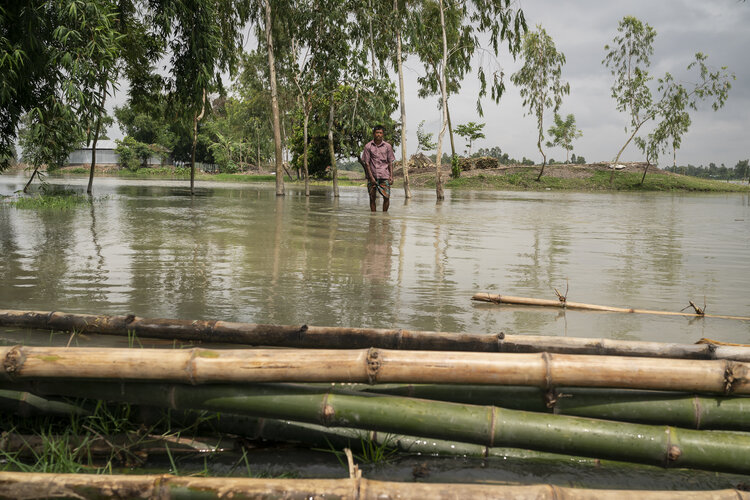Climate Change
Overview
As well as being impacted by the changing climate, the agriculture sector is a significant contributor of emissions, and hence management practices that can minimise emissions and prevent the loss of soil carbon are important considerations in minimising wider scale impacts. Options are needed that can help farmers build resilience to climate change and mitigate emissions while at the same time maintaining or improving food security.
ACIAR SDIP’s contribution to improved resource use efficiency and climate smart production systems in the EGP includes a multi-scale understanding of the situation, from farm scale to regional levels.

Climate change trends and impact on agriculture
Over the next century, climate change will adversely impact the agriculture sector in South Asia, jeopardising food security and rural livelihoods. By 2050, average annual temperatures are projected to be between 1°C-1.5°C higher. Total rainfall will slightly increase, but this will be more in the summer seasons with higher intensity, and at the expense of winter rainfall. Underlying changes to average mean temperatures are the most significant threat in the long term and will push many regions beyond optimal growing conditions and reduce growing season length, particularly during the Rabi (winter) season.
Promoting CA for emissions mitigation and adaptation
Extensive on-farm trials tested sustainable farming systems based on conservation agriculture (CA) and considered their performance in terms of climate change mitigation and adaptation. CA practices can reduce indirect on-farm emissions by 6 – 18% as evidenced by trials in eight locations across the EGP. Importantly, these reductions do not need to come at the expense of productivity or profitability, creating win-win situations for farmers, rural agribusinesses and governments alike, who are all struggling to find ways to adapt to climate change and reduce future levels of emissions.
The performance and mitigation potential of CA-based approaches were modelled under different climate regimes to consider performance over the long term. The practice changes tested also have positive impacts on soil health in terms of the amount and types of carbon present, and improved soil structure. At the same time, these climate smart farming systems can be profitable for farmers and local businesses, creating new employment opportunities for women and rural youth.
Avoiding emissions through better resource management
Identifying and managing soil acidity through better management of nitrogen fertiliser offers the potential to reduce emissions. The soils of the EGP are poorly pH buffered, and hence at risk of acidification through crop harvest and nitrogen (N) fertiliser use. Acid soils threaten agricultural productivity, by causing problems with nutrient availability and nodulation of legume crops. A major strategy to halt acidification is better management of N fertiliser use efficiency, to ensure minimum losses from the system. Efficient use of N fertilizer can also have a positive greenhouse gas impact, through reducing the amount of N applied, hence reducing emissions associated with N fertiliser manufacturing, and the amount of N lost from the soil. In the long-term this may be more important than the carbon dynamics of a system.
Interacting policy drivers for resource management
Focused work on groundwater offers an option to improve climate change adaptation and resilience, given likely impacts on rainfall timing, quantity and intensity. At present, groundwater in the EGP is an underutilised resource in most areas, and so a better understanding of availability and the implications of its management alongside energy and food policies is critical to maintain sustainability.
Rice based cropping systems result in a high level of crop residue after harvest that must be managed before a subsequent crop can be grown; in the west of India, this crop residue is often burned within the narrow timeframe available for planting the subsequent crop. This contributes detrimentally to atmospheric pollution and greenhouse gas emissions. Stubble burning is currently practiced at low levels in the EGP, but is likely to increase as mechanical harvesting and systems intensification increase. Zero-till crop establishment methods, including the Happy Seeder, are an option to allow a subsequent crop to be sown into standing rice stubble. The adoption of zero till crop establishment methods could reduce future CO2 emissions significantly by eliminating the need for stubble burning in the EGP.
Avoiding future emissions from different parts of the agricultural system may have more potential impact in the long-run than building soil organic carbon, as this by its nature reaches a new equilibrium after which no additional gains can be made. Reducing emissions associated with residue burning and better management of nitrogen use efficiency are pathways that can have positive benefits in the future.
At the ACIAR SDIP Final Review, program team members Brian Dawson, Professor Ram Dalal, Dr Apurbo Chaki and Dr Mahesh Gathala joined Tamara Jackson for a discussion about climate change issues and opportunities in the EGP. Watch a recording of the discussion here.